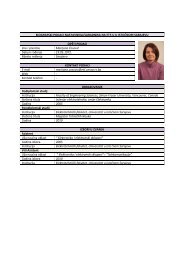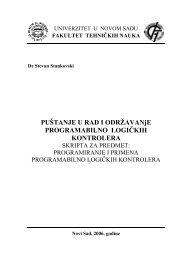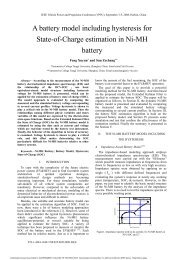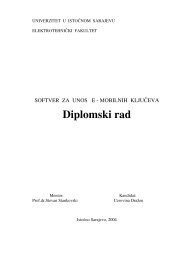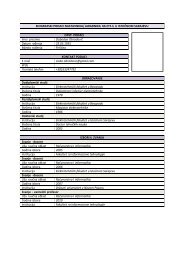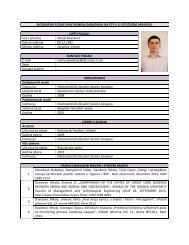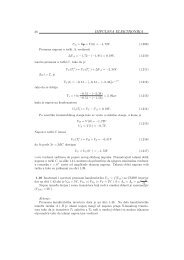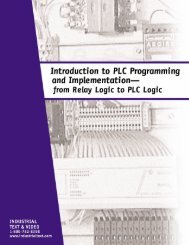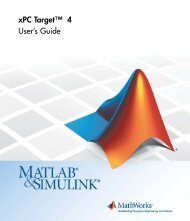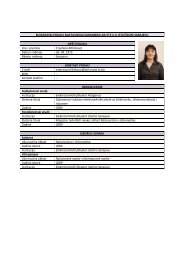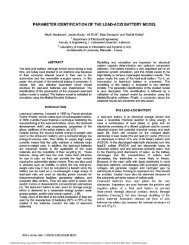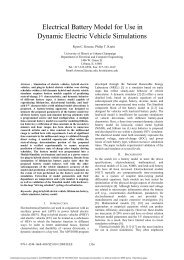Accurate Electrical Battery Model Capable of Predicting Runtime ...
Accurate Electrical Battery Model Capable of Predicting Runtime ...
Accurate Electrical Battery Model Capable of Predicting Runtime ...
You also want an ePaper? Increase the reach of your titles
YUMPU automatically turns print PDFs into web optimized ePapers that Google loves.
CHEN AND RINCÓN-MORA: BATTERY MODEL CAPABLE OF PREDICTING RUNTIME AND I–V PERFORMANCE 511<br />
TABLE IV<br />
MODEL VALIDATION RESULTS (NIMH BATTERY)<br />
response within 15 mV <strong>of</strong> accuracy and runtime within a 0.34%<br />
margin.<br />
REFERENCES<br />
[1] D. Linden and T. B. Reddy, Handbook <strong>of</strong> Batteries, McGraw-Hill, 3rd ed.<br />
New York: McGraw-Hill, 2002.<br />
[2] L. C. Brush, “Portable devices emerging power solutions,” EDN Power<br />
Supplement, pp. 23–26, Nov. 2003.<br />
[3] E. Y. Chu, “New challenges for rechargeable batteries,” EDN Power Suplement,<br />
pp. 13–20, Sep. 2002.<br />
[4] L. Benini, G. Castelli, A. Macci, E. Macci, M. Poncino, and R. Scarsi,<br />
“Discrete-time battery models for system-level low-power design,” IEEE<br />
Trans. VLSI Syst., vol. 9, no. 5, pp. 630–640, Oct. 2001.<br />
[5] R. Rao, S. Vrudhula, and D. N. Rakhmatov, “<strong>Battery</strong> modeling for<br />
energy-aware system design,” Computer, vol. 36, no. 12, pp. 77–87, Dec.<br />
2003.<br />
[6] H. L. Chan and D. Sutanto, “A new battery model for use with<br />
battery energy storage systems and electric vehicles power systems,”<br />
in Proc. IEEE PES Winter Meeting, vol. 1, Jan. 23–27, 2000, pp.<br />
470–475.<br />
[7] C. J. Zhan, X. G. Wu, V. K. Ramachandaramurthy, M. Barnes, N. Jenkins,<br />
and A. J. Ruddell, “Two electrical models <strong>of</strong> the lead-acid battery used in<br />
a dynamic voltage restorer,” in IEE Proc. Generation, Transmission, and<br />
Distribution, vol. 150, no. 2, Mar., pp. 175–182, 200.<br />
[8] M. Pedram and Q. Wu, “Design considerations for battery-powered electronics,”<br />
in Proc. 1999 Des. Autom. Conf., pp. 861–866.<br />
[9] P. H. Chou, C. Park, J. Park, K. Pham, and J. Liu, “B#: A battery emulator<br />
and power pr<strong>of</strong>iling instrument,” in Proc. Int. Symp. Low Power Design,<br />
2003, pp. 288–293.<br />
[10] C. F. Chiasserini and R. R. Rao, “Energy efficient battery management,”<br />
IEEE J. Sel. Areas Commun., vol. 19, no. 7, pp. 1235–1245, Jul. 2001.<br />
[11] L. Song and J. W. Evans, “Electrochemical-thermal model <strong>of</strong> lithium<br />
polymer batteries,” J. Electrochem. Soc., vol. 147, pp. 2086–2095, 2000.<br />
[12] P. M. Gomadam, J. W. Weidner, R. A. Dougal, and R. E. White, “Mathematical<br />
modeling <strong>of</strong> lithium-ion and nickel battery systems,” J. Power<br />
Sources, vol. 110, no. 2, pp. 267–24, Aug. 2002.<br />
[13] D. W. Dennis, V. S. Battaglia, and A. Belanger, “Electrochemical modeling<br />
<strong>of</strong> lithium polymer batteries,” J. Power Source, vol. 110, no. 2, pp. 310–<br />
320, Aug. 2002.<br />
[14] J. Newman, K. E. Thomas, H. Hafezi, and D. R. Wheeler, “<strong>Model</strong>ing <strong>of</strong><br />
lithium-ion batteries,” J. Power Sources, vol. 119–121, pp. 838–843, Jun.<br />
2003.<br />
[15] R. Rynkiewicz, “Discharge and charge modeling <strong>of</strong> lead acid batteries,”<br />
in Proc. Appl. Power Electron. Conf. Expo., vol. 2, 1999, pp. 707–710.<br />
[16] D. Rakhmatov, S. Vrudhula, and D. A. Wallach, “A model for battery<br />
lifetime analysis for organizing applications on a pocket computer,” IEEE<br />
Trans. VLSI Syst., vol. 11, no. 6, pp. 1019–1030, Dec. 2003.<br />
[17] P. Rong and M. Pedram, “An analytical model for predicting the remaining<br />
battery capacity <strong>of</strong> lithium-ion batteries,” in Proc. Design, Automation,<br />
and Test in Europe Conf. and Exhibition, 2003, pp. 1148–1149.<br />
[18] P. E. Pascoe and A. H. Anbuky, “VRLA battery discharge reserve time<br />
estimation,” IEEE Trans. Power Electron., vol. 19, no. 6, pp. 1515–1522,<br />
Nov. 2004.<br />
[19] Z. M. Salameh, M. A. Casacca, and W. A. Lynch, “A mathematical model<br />
for lead-acid batteries,” IEEE Trans. Energy Convers., vol. 7, no. 1, pp. 93–<br />
98, Mar. 1992.<br />
[20] M. Valvo, F. E. Wicks, D. Robertson, and S. Rudin, “Development and<br />
application <strong>of</strong> an improved equivalent circuit model <strong>of</strong> a lead acid battery,”<br />
in Proc. Energy Convers. Eng. Conf., vol. 2, Aug. 1996, pp. 1159–1163.<br />
[21] M. Ceraolo, “New dynamical models <strong>of</strong> lead-acid batteries,” IEEE Trans.<br />
Power Syst., vol. 15, no. 4, pp. 1184–1190, Nov. 2000.<br />
[22] S. Barsali and M. Ceraolo, “Dynamical models <strong>of</strong> lead-acid batteries:<br />
Implementation issues,” IEEE Trans. Energy Convers., vol. 17, no. 1,<br />
pp. 16–23, Mar. 2002.<br />
[23] B. Schweigh<strong>of</strong>er, K. M. Raab, and G. Brasseur, “<strong>Model</strong>ing <strong>of</strong> high power<br />
automotive batteries by the use <strong>of</strong> an automated test system,” IEEE Trans.<br />
Instrum. Meas., vol. 52, no. 4, pp. 1087–1091, Aug. 2003.<br />
[24] L. Gao, S. Liu, and R. A. Dougal, “Dynamic lithium-ion battery model<br />
for system simulation,” IEEE Trans. Compon. Packag. Technol., vol. 25,<br />
no. 3, pp. 495–505, Sep. 2002.<br />
[25] M. C. Glass, “<strong>Battery</strong> electrochemical nonlinear/dynamic SPICE model,”<br />
in Proc. Energy Convers. Eng. Conf., vol. 1, 1996, pp. 292–297.<br />
[26] S. Buller, M. Thele, R. W. D. Doncker, and E. Karden, “Impedancebased<br />
simulation models <strong>of</strong> supercapacitors and Li-ion batteries for power<br />
electronic applications,” in Conf. Rec. 2003 Ind. Appl. Conf., vol.3,<br />
p. 159601600.<br />
[27] P. Baudry, M. Neri, M. Gueguen, and G. Lonchampt, “Electro-thermal<br />
modeling <strong>of</strong> polymer lithium batteries for starting period and pulse power,”<br />
J. Power Sources, vol. 54, no. 2, pp. 393–396, Apr. 1995.<br />
[28] S. C. Hageman, “Simple pspice models let you simulate common battery<br />
types,” EDN, pp. 17–132, Oct. 1993.<br />
[29] S. Gold, “A pspice macromodel for lithium-ion batteries,” in Proc. 12th<br />
Annu. <strong>Battery</strong> Conf. Applications and Advances, 1997, pp. 215–222.<br />
[30] S. Abu-Sharkh and D. Doerffel, “Rapid test and non-linear model characterization<br />
<strong>of</strong> solid-state lithium-ion batteries,” J. Power Sources, vol. 130,<br />
pp. 266–274, 2004.<br />
power sources.<br />
Min Chen (S’04) was born in Jingdezhen, China.<br />
He received the B.Eng. degree (with highest honors)<br />
and the M.Eng. degree in electrical engineering<br />
from Southeast University, Nanjing, China, in 1999<br />
and 2002, respectively. He is currently pursuing the<br />
Ph.D. degree in electrical and computer engineering<br />
at the Georgia Institute <strong>of</strong> Technology, Atlanta.<br />
His research interests are in the area <strong>of</strong> analog<br />
and power IC design, more specifically, battery and<br />
fuel cell modeling, high-efficiency charger IC design,<br />
and integrated power management for hybrid<br />
Gabriel A. Rincón-Mora (S’91–M’97–SM’01) was<br />
born in Caracas, Venezuela. He received the B.S. degree<br />
(high honors) from the Florida International University,<br />
Miami, and the M.S.E.E. and Ph.D. degrees<br />
from the Georgia Institute <strong>of</strong> Technology (Georgia<br />
Tech.), Atlanta, in 1992, 1994, and 1996, respectively,<br />
all in electrical engineering.<br />
From 1994 to 2001, he worked for Texas Instruments,<br />
as a Senior Integrated Circuits Designer, Design<br />
Team Leader, and Member <strong>of</strong> Group Technical<br />
Staff. In 1999, he was appointed as an Adjunct Pr<strong>of</strong>essor<br />
at Georgia Tech., where he became a full-time faculty member <strong>of</strong> the<br />
School <strong>of</strong> <strong>Electrical</strong> and Computer Engineering in 2001. He has authored Voltage<br />
References—From Diodes to Precision High-Order Bandgap Circuits (New<br />
York, Wiley IEEE Press, 2001) and various conference/journal publications. He<br />
is the holder <strong>of</strong> 22 patents in the field <strong>of</strong> analog and power integrated circuits.<br />
His work focuses on integration (power passives, control circuitry, batteries, and<br />
energy-harvesting sources), high performance, and power efficiency <strong>of</strong> solidstate<br />
devices, circuits, and systems in various flavors <strong>of</strong> Bipolar, CMOS, and<br />
BiCMOS process technologies.<br />
Dr. Rincón-Mora was the Director <strong>of</strong> the Georgia Tech. Analog Consortium.<br />
He was the Vice-Chairman for the Atlanta IEEE Solid-State Circuits Society-<br />
Circuits and Systems (SSCS-CAS) Chapter for 2004 and is now the Chairman.<br />
He was the recipient <strong>of</strong> the National Hispanic in Technology Award from the Society<br />
<strong>of</strong> Pr<strong>of</strong>essional Hispanic Engineers; the Charles E. Perry Visionary Award<br />
from the Florida International University; a Commendation Certificate from the<br />
Lieutenant Governor <strong>of</strong> California for his work and contributions to the field.<br />
He was inducted into the “Council <strong>of</strong> Outstanding Young Engineering Alumni”<br />
by Georgia Tech. and featured the cover <strong>of</strong> Hispanic Business Magazine as one<br />
<strong>of</strong> “The 100 Most Influential Hispanics” and La Fuente (Dallas Morning News<br />
publication), and Nuevo Impacto (Atlanta-based magazine). He is a Member<br />
<strong>of</strong> Tau Beta Pi, Eta Kappa Nu, Phi Kappa Phi, and the Society <strong>of</strong> Hispanic<br />
Pr<strong>of</strong>essional Engineers.<br />
Authorized licensed use limited to: GOVERNMENT COLLEGE OF TECHNOLOGY. Downloaded on December 31, 2009 at 04:50 from IEEE Xplore. Restrictions apply.



